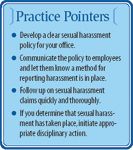Article
Sexual harassment: What you can do to avoid it
Author(s):
The victim does not have to be the person harassed, but could be anyone affected by the offensive conduct.

Sexual harassment is not a recent problem, although legal liability for it is. The subject received wide media attention in 1991, when the Senate Judiciary Committee held hearings on Anita Hill's charges against Supreme Court nominee Clarence Thomas.

Sexual harassment is any kind of sexual behavior that is unwelcome and/or inappropriate for the workplace, according to Bourque. Sexual harassment also includes verbal harassment (eg, derogatory comments and inappropriate jokes), visual harassment (eg, derogatory or embarrassing posters, cartoons, drawings, etc.), unwanted physical harassment, and requests for sexual favors for purposes of advancement, raises, or job retention.
Title VII of the Civil Rights Act of 1964 prohibits discriminatory practices in the workplace, specifically, on the basis of race, color, sex, national origin, and religion. Title VII's prohibitions against sexual discrimination also cover sexual harassment and pregnancy-based discrimination. Bourque cautions that it is illegal to ask a prospective employee about the number of children they have or when they plan to have children.
Bourque points out that Title VII applies only to employers with 15 or more employees. However, she advises that medical practices with fewer than 15 employees should still prohibit sexual discrimination and harassment and have a policy for addressing complaints of sexual harassment.
Recognizing sexual harassment
Sexual harassment can occur in a variety of circumstances:
There are two recognized types of sexual harassment: quid pro quo sexual harassment and hostile environment sexual harassment.
Quid pro quo (Latin for "something for something") sexual harassment occurs when an individual's submission or rejection of sexual advances is used as the basis for employment decisions, eg, getting a job, retaining a job, or granting sexual favors for the purpose of advancement. It is important to note that employers/physicians are strictly liable for quid pro quo sexual harassment initiated by supervisory employees of a practice.
Hostile environment sexual harassment occurs when unwelcome sexual conduct unreasonably interferes with an individual's job performance or creates a hostile, intimidating, or offensive work environment, even though the harassment may not result in economic consequences. Hostile environment sexual harassment might include repeated requests for sexual favors, offensive language, and sexually offensive cartoons, calendars, literature, or photographs displayed in plain view.
















